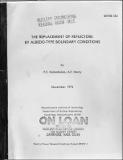| dc.contributor.author | Kalambokas, Panagiotis Constantinos | en_US |
| dc.contributor.author | Henry, Allan F. | en_US |
| dc.contributor.other | Massachusetts Institute of Technology. Department of Nuclear Engineering | en_US |
| dc.contributor.other | Electric Power Research Institute | en_US |
| dc.date.accessioned | 2014-09-16T23:35:48Z | |
| dc.date.available | 2014-09-16T23:35:48Z | |
| dc.date.issued | 1975 | en_US |
| dc.identifier.uri | http://hdl.handle.net/1721.1/89727 | |
| dc.description | "November, 1975." | en_US |
| dc.description | Also issued as an Sc. D. thesis by the first author and supervised by the second author, MIT Dept. of Nuclear Engineering, 1976 | en_US |
| dc.description | Includes bibliographical references (pages 221-224) | en_US |
| dc.description.abstract | The idea of the representation of reflectors by boundary conditions in static and dynamic reactor calculations is investigated. Analytical, group-diffusion theory boundary conditions relating neutron flux to normal current at core-reflector interfaces in terms of the reflector parameters are derived and applied for the implicit treatment of reflectors. Kirchhoff's formula of optics, translated into the neutron-diffusion language, is the general relation from which boundary conditions for various reflector configurations (slab, wedge, elbow), geometrically separable or not, are obtained. The integral form of these boundary conditions in space and/or time generally being unswited for computer implementation, a reduction to simle, approximate algebraic forms is carried out. The finite diffusion length and/or the finite neutron lifetime in various reflector materials are exploited in the above reduction. | en_US |
| dc.description.abstract | The bulk of the applications of the reflector-replacement method are for two-dimensional, light water-reflected reactor models with typical, step-like core-reflector interfaces, in steady state. With these models it is found that, if the reflector is viewed as consisting of many, narrow channels perpendicular to the interface and the transchannel leakage is neglected, (so that the one-dimensional- slab boundary conditions can be used to represent the reflector), the accuracy of the method, is extremely good for large, shrouded cores, decreases with core-size and is poor when the surface of a small, unshrouded core contains reentrant corners. | en_US |
| dc.description.abstract | In the latter case the accuracy is improved by either the explicit treatment of a light water buffer zone, about 2 cm thick, adjacent to the core and the representation of the rest of the reflector by one-dimensional-slab boundary conditions, or the employment of numerical corrections generated internally during the computation or the employment of simple, analytical corrections derived from the infinite-wedge-shaped reflector configuration. The replacement of light water reflectors in transients and the replacement of heavy water or graphite reflectors in steady state or transients are studied in a preliminary way. Excellent results are obtained from the implicit treatment of light water reflectors of one-dimensional-slab geometry in fast transients. Heavy water or graphite reflectors are found to be more difficult to replace by boundary conditions because of their longer diffusion lengths and neutron lifetimes. | en_US |
| dc.description.abstract | In all cases, the computational cost is reduced by about 40% when the reflector is treated implicitly. | en_US |
| dc.description.sponsorship | Electric Power Research Institute project RP227-1 | en_US |
| dc.format.extent | 263 pages | en_US |
| dc.publisher | Cambridge, Mass. : Massachusetts Institute of Technology, Dept. of Nuclear Engineering, [1975] | en_US |
| dc.relation.ispartofseries | MITNE ; no. 183 | en_US |
| dc.subject.lcc | TK9008.M41 N96 no.183 | en_US |
| dc.title | The replacement of reflectors by Albedo-type boundary conditions | en_US |
| dc.type | Technical Report | en_US |
| dc.identifier.oclc | 857063075 | en_US |
